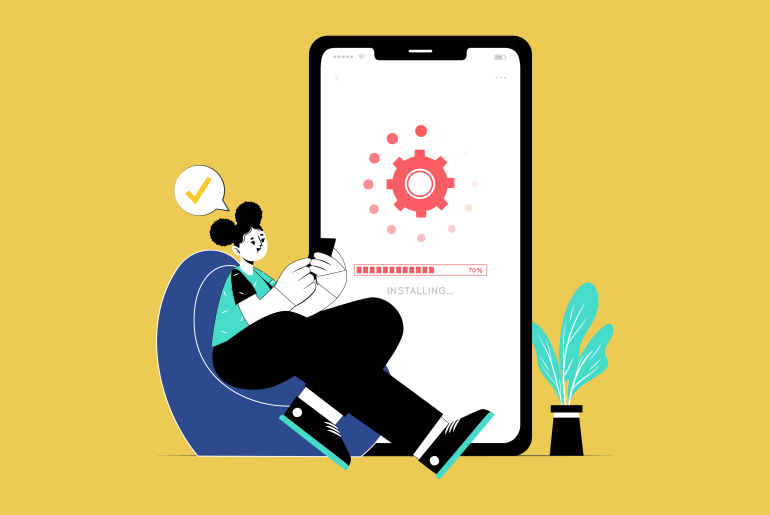We live in a mobile-first world where anything you want can easily be found on your smartphone. Mobile applications are becoming increasingly popular in the current digital landscape. Additionally, a user-friendly mobile app benefits both customers and business owners. With a user-friendly designed app, businesses can add value for consumers, expand their offerings, and enhance engagement. So, if you are thinking of developing a successful mobile app, you need to consider far more than the purpose it serves.
With a tremendously user-friendly mobile app, capturing the attention of smartphone users is easily possible. Moreover, app stores promote apps that offer high-quality interfaces, intuitive navigation, and ultra-smooth user experience. As a business, you need to understand the core features that make your app user-friendly before you get into app designing. Top devops consulting companies understand that to compete in the acceleration economy; user engagement must be on top priority. With this in consideration, let’s know about the features in detail that make your app user-friendly.
Table of Contents
Features that Make Your App User-friendly
Developing a successful mobile app is challenging; however, incorporating user-friendly features will help its chance of success. So, let’s get started without further ado. Here are the top features you must consider when designing and developing effective mobile apps.
User Interface
A mobile app should have a simple user interface that is responsive and receptive. Your end users want a seamless experience and clearly understand which buttons perform which actions. Create a user interface layout that directly targets and solves the user’s problem with little effort as possible. As mobile device screens are not designed to accommodate complicated structures, a simple user interface is an essential feature you can offer to your clients.
Intuitive navigation
An app’s navigation greatly influences how user-friendly it is. Difficult navigation increases the app abandonment rate. So, when designing an app, make sure navigating within the app should feel natural, with elements integrated and linked in ways that users easily understand. Understand the app’s aspects that users need most and keep them prominent in the user’s flow. One of the best ways is to keep a search bar or dropdown menu for users to navigate through the app.
Data Privacy and security
Data privacy and security are among the significant aspects that today’s users are concerned about. Users are more comfortable using the app when they know their data and personal information security. You can incorporate double-factor authentication systems for a seamless user experience. So, the security features must be regularly updated to keep the app safe from any external breaches and vulnerabilities. Additionally, an articulated data privacy policy will put users at ease and encourage them to use the app.
Personalization
While designing and developing an app, you can use demographics, contextual, and behavioral user personas to provide your users with more personalized content. Today’s users are more inclined towards mobile, personalized experiences. Delivering them what they need directly impacts your app’s engagement rate. Additionally, mobile app personalization is crucial if you want to connect with consumers and experience real growth.
Offline capabilities
Giving an app offline capabilities empowers your users to access the app anywhere they go. It directly maximizes usability and increases the dependency of users on the app. Some of the features should be available offline, such as saved articles, searches, and primary elements that can be accessed without an internet connection. Additionally, offline capabilities become necessary for apps intended to store information that a user might need at any time.
Reviews, feedback, and customer support
Users love it when they get instant solutions to issues they are facing. So, an app must incorporate a customer support feature to deliver a seamless user experience. Additionally, allowing users to review or give feedback about your app lets you learn what your customers think about you. Even negative criticism can be used to make your app better over time.
Push notifications
The notifications feature is among the most popular way of maintaining and gaining users’ attention. Targeted push notifications are the key to driving user retention and re-engagement on your app. Push notifications are the best way to deliver personalized content to your users. Always keep your alerts simple, action-driven, and limited to see the best results.
Multi-device synchronization
Synchronizing data across different devices is now essential for any mobile application. It helps users get a consistent app experience across other devices regardless of their size or version of the operating system. Your app will become more scalable if your app supports real-time synchronization on different devices and platforms.
Simplified app onboarding
A simplified app onboarding process will likely increase your app adoption rate. You need to design and develop an app onboarding process that is easily understandable and encourages users to keep using the app. A simplified app onboarding process directly impacts user retention and builds long-term engagement.
Social media sharing
In the current digital era, where social media prevails, you need to incorporate social media sharing features into your app. This feature facilitates communication between people and lets users feel more connected. Also, it encourages other users to use your app as well. For instance, an eCommerce app that allows users to share product details will generate higher revenue as more people can access that product via the application.
Wrapping Up!
Hope you liked the information shared above on the top features that makes your app user-friendly. The user experience plays a critical role in the success of the app’s lifecycle. A well-designed app allows users to take action easily, traverse through the app smoothly, and prevent users from becoming frustrated. To ensure your app is efficient and delivers a good customer experience, focus on the app design, as it should not suppress the potential value the app offers to its users. Additionally, if you want to assess the user-friendliness of your app, look at how straightforward the app is for a new user, its ease of navigation, and how well it integrates with the target user’s workflow.


